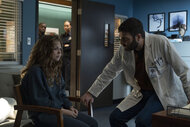Create a free profile to get unlimited access to exclusive show news, updates, and more!
Brilliant Minds Explores CTE and PTSD in Hospital Drama's Latest Medical Mystery
Brilliant Minds' fifth episode explores an invisible threat to combat veterans.

Medicine was the backup plan for Brilliant Minds' Dr. Jacob Nash (Spence Moore II). He was on track for a career in professional football when he took a couple of knocks to the head and was told if he suffered one more concussion, he might not wake up. So he traded pads and a helmet for scrubs and a stethoscope.
RELATED: Brilliant Minds Creator Promises a Medical Drama That Isn't "Tidy"
Jacob's prior brain injuries come back to haunt him in the fifth episode of Brilliant Minds, when the team at Bronx General meets Steve Hill, a marine veteran suffering from apparent PTSD. Recently, Hill has been experiencing increased anxiety, depression, intrusive thoughts, and visions of lost friends. He’s got a baby on the way and he’s hoping Dr. Oliver Wolf (Zachary Quinto) and the rest of the team can help him before the baby arrives.
At first blush, Hill’s symptoms sound like textbook, combat-related post-traumatic stress disorder (PTSD). The only trouble is that Hill never actually saw combat. No one in his unit did, and there’s nothing in their records that suggests they should be at heightened risk of PTSD. Yet, half of that unit has since met untimely ends and Hill appears to be going down the same deadly path.
By the end of the episode, "The Haunted Marine," we learn the culprit was exposed to the chronic concussive forces of artillery fire and the damaging effects of those forces on the brain. Hill never saw the front lines, but it was like he was being football tackled over and over, every day, for his entire deployment.
Understanding Chronic Traumatic Encephalopathy (CTE)
Doctors and scientists have known for a long time that continued head trauma leads to neurological degeneration. Over the years, it’s been called various names, including dementia pugilistica (boxer’s dementia) or punch-drunk syndrome. Today, we call it chronic traumatic encephalopathy (CTE).
CTE has been in the news in recent years after many American football players, boxers, ice hockey players, professional wrestlers, and other athletes were diagnosed post-mortem. Unfortunately, the only way to definitively diagnose CTE is through an examination of the brain tissue after death.
In the Brilliant Minds episode, the doctors get around that by examining the brain of a deceased soldier from the same unit.
RELATED: What Is Maple Syrup Urine Disease? A Brilliant Minds Medical Mystery
The precise causes and mechanisms of the disease aren’t wholly understood, but CTE has been linked to repeated head trauma or concussions over an extended period. It may also be related to “second impact syndrome,” which occurs when a second head injury takes place before the first has fully healed. Not everyone who has repeated concussions will develop CTE, but people who play contact sports, victims of assault, and people who have suffered blast injuries are at higher risk.
Long-term, CTE typically leads to atrophy of the frontal and temporal cortices, along with other areas of the brain, and an overall reduction in brain weight. CTE patients also exhibit a build-up of a protein called tau. Symptoms usually show up about 10 years after repeated brain injuries, starting small and becoming more severe over time. Early symptoms include headaches, dizziness, mood changes, personality changes, and behavioral changes. As the disease progresses, symptoms include depression, suicidal thoughts, loss of judgment, impulsive behavior, aggression, memory loss, confusion, loss of mobility, and trouble planning and executing tasks.
RELATED: Brilliant Minds' Zachary Quinto Initially Struggled to Understand This About Oliver Sacks
CTE symptoms can be treated but the disease can’t be cured, so prevention is the recommended course whenever possible. Wear helmets, mouth guards, and other safety equipment while playing contact sports. Because repeated injury is believed to increase risk, give yourself time to fully recover from any injury before you get back on the field, whether that’s a football field or a field of battle.
How Common Is PTSD Among Military Veterans?
While Hill’s symptoms weren’t caused by PTSD, at least not exclusively, it makes sense that it was the first diagnosis. Overall, PTSD is only slightly more common among veterans than the general population. On average, 7 out of 100 veterans experience PTSD over the course of a lifetime, compared to 6 out of 100 in the general population. The story gets a little more complicated, however, when we start looking at subgroups within the veteran population.
One of the most obvious separations is along gender lines. Male veterans experience a 6% prevalence of PTSD, in line with the general population, while 13% of female veterans report PTSD symptoms. That’s likely at least partly the result of Military Sexual Trauma (MST), which is known to increase the risk of PTSD. While MST can occur to anyone in the military, it’s reported in as many as 1 in 3 women veterans. Data on transgender and non-binary veterans is still being gathered, along with data for veterans of color and LGBTQIA+ veterans, according to the VA.
RELATED: Understanding Face Blindness: Seeing Through the Eyes of Brilliant Minds' Dr. Wolf
Importantly, the above numbers are averages across a lifetime and don’t take into account differences in combat experience. Veterans from the Vietnam War, for instance, have a 10% risk of PTSD on average, over the course of a lifetime. Desert Storm veterans come in at approximately 21%, and veterans of the Iraq War have a staggering 29% incidence of PTSD. The apparent increase is likely due in part to improved awareness and diagnosis.
Even still, they are conservative estimates for one very important reason: The data only includes veterans who were still alive at the time of the study. It necessarily excludes anyone who had already died as a result of their symptoms and therefore underestimate the actual rates of PTSD among veterans.
PTSD Mortality Rate Among Vets
The cost to life is difficult to determine. PTSD can claim a life through substance abuse or reckless behavior just as easily as it can claim a life through suicide. Often, a death that appears to have another cause may ultimately trace its roots back to PTSD, making the true death toll higher than it appears.
Research has found that any level of PTSD is associated with roughly twice the suicide mortality rate of the background population. The good news is that suicide risk decreases over time, especially with treatment.
PTSD Resources, Education, Treatment, and Support
If you’re experiencing symptoms of PTSD, help is available, and you don’t have to go it alone. The VA website offers a wide range of information including a self-check quiz and an online PTSD screening.
If you’re in crisis and need immediate help, the Veterans Crisis Line is available 24 hours a day and offers confidential support. You can reach the crisis line at 800-273-8255, then press 1. Or send a text message to 838255. You can also chat with someone confidentially online.
You can find additional PTSD information and resources from the National Center for PTSD through the Department of Veterans Affairs, which offers education, treatment options, and support for veterans and their families.
New episodes of Brilliant Minds premiere on Mondays on NBC at 10/9c and are available to stream on Peacock.
















